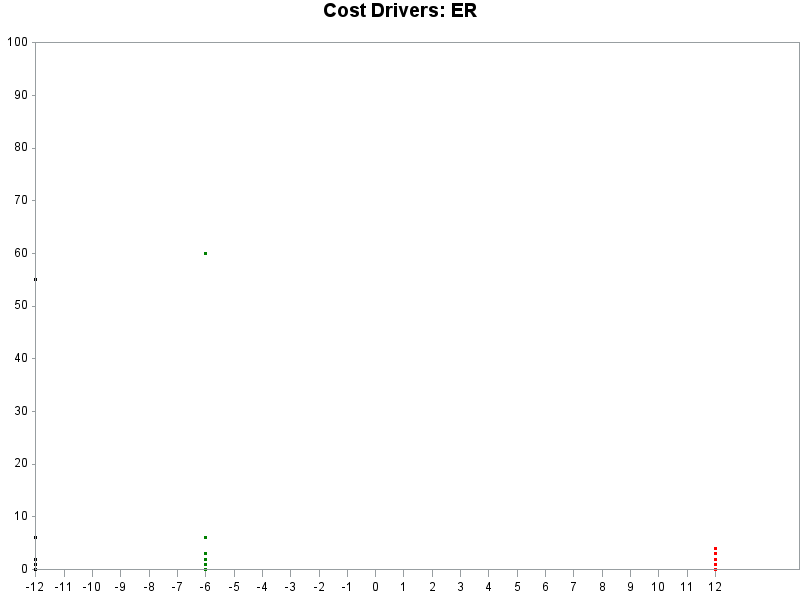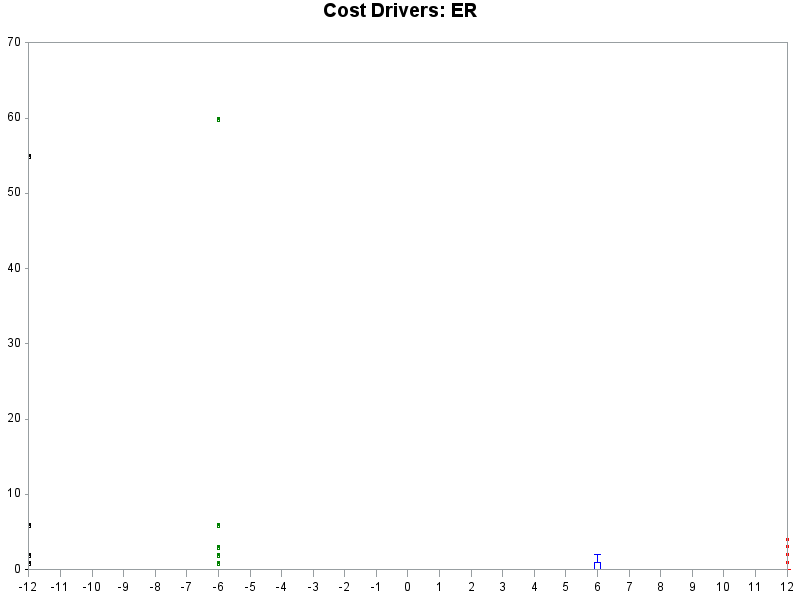- Home
- /
- Programming
- /
- Graphics
- /
- Re: Help creating graph with multiple series
- RSS Feed
- Mark Topic as New
- Mark Topic as Read
- Float this Topic for Current User
- Bookmark
- Subscribe
- Mute
- Printer Friendly Page
- Mark as New
- Bookmark
- Subscribe
- Mute
- RSS Feed
- Permalink
- Report Inappropriate Content
Hello,
I am looking to create a graph with the following characteristics:
- X-Axis: Timepoint (months) -12, -6, 0, 6, 12 *Note: the - refers to that many months before study entry
- Y-Axis: Days in Hospital at 12 months before study entry (coincides with -12 m timepoint)
- Y-Axis: Days in Hospital at 6 months before study entry (coincides with -6 m timepoint)
- Y-Axis: Days in Hospital at 6 months post study entry (coincides with 6 m timepoint)
- Days in Hospital at 12 months post study entry (coincides with 12 m timepoint)
Each of those y-axis variables is one variable in the dataset. I want to create a scatterplot in a series format and then have the mean display on the graph. I tried using ODS graphics designer and am only able to create a scatter for one y-axis variable. Is it possible to do a series for this with the graphics editor? If not, how could I go about doing this?
Thanks!
- Mark as New
- Bookmark
- Subscribe
- Mute
- RSS Feed
- Permalink
- Report Inappropriate Content
With SAS/Graph Proc Gplot, you can plot multiple different y-variables on the same graph using the 'overlay' option:
If you have 2 different ranges of values, you can use gplot's "plot2" for the 2nd axis (on the right-hand-side):
http://robslink.com/SAS/democd21/climate.htm
And if you need more than 2 different y-axes, you could get a little tricky with annotate:
http://robslink.com/SAS/democd41/multi_y.htm
For the mean line, you could calculate that value and store it in a macro variable, and then use that value as a 'refline' or annotate a line at that value.
Are any of these similar to what you're wanting? (If not, give some more specifics/details of what you're looking for.)
- Mark as New
- Bookmark
- Subscribe
- Mute
- RSS Feed
- Permalink
- Report Inappropriate Content
Thanks for the info... the range of values on the y-axis is the same for all, so won't be necessary to use 2nd axis I don't think.
How would I set this up in Proc Gplot?
- Mark as New
- Bookmark
- Subscribe
- Mute
- RSS Feed
- Permalink
- Report Inappropriate Content
Using some of the easily-available sample data we ship with SAS, here's a simple example:
symbol1 value=dot interpol=join color=red;
symbol2 value=dot interpol=join color=blue;
symbol3 value=dot interpol=join color=green;
proc gplot data=sashelp.class;
plot age*name=1 weight*name=2 height*name=3 / overlay;
run;
- Mark as New
- Bookmark
- Subscribe
- Mute
- RSS Feed
- Permalink
- Report Inappropriate Content
Thanks, that works. How do I get the plot to not join lines between the datapoints? I just want to show the datapoints on the graph but do not want the points joined in any way.
- Mark as New
- Bookmark
- Subscribe
- Mute
- RSS Feed
- Permalink
- Report Inappropriate Content
If you're asking about gplot ... you can use interpol=none, rather than interpol=join
- Mark as New
- Bookmark
- Subscribe
- Mute
- RSS Feed
- Permalink
- Report Inappropriate Content
Thanks that works! How do I get the x and y axis to join at 0 so that -12 and -6 month timepoints are to the left of the y axis?
- Mark as New
- Bookmark
- Subscribe
- Mute
- RSS Feed
- Permalink
- Report Inappropriate Content
You can specify axis statements (with whatever range you want, using the order= axis option), and assign them to the graph using the haxis and vaxis gplot options.
- Mark as New
- Bookmark
- Subscribe
- Mute
- RSS Feed
- Permalink
- Report Inappropriate Content
I've attached the plot that I have right now and my code is at the bottom of this question screen. Here's what I still need to do with it/some questions:
- Add means as bars on the graph to designate the average of each of the four variables (ERDAYS_PRE_3 ERDAYS_PRE_4 ERDAYS_3 ERDAYS_4)
- Move the y-axis so that it is at 0
- Add in values for ERDAYS_3 - for some reason they don't show up on the graph?
CODE:
/*Setup plot for ER cost driver data*/
symbol1 value=dot interpol=none color=red;
symbol2 value=dot interpol=none color=blue;
symbol3 value=dot interpol=none color=green;
symbol4 value=dot interpol=none color=black;
axis1 order=(-12 to 12 by 1) offset=(0,12)
label=none minor=none;
axis2 order=(0 to 100 by 10) offset=(0,0)
label=none minor=none;
proc gplot data=CostDrivers;
plot ERDAYS_PRE_3*time_6=3 ERDAYS_PRE_4*time_12=4 ERDAYS_4*time12=1 ERDAYS_3*time6=2 / overlay
haxis=axis1
vaxis=axis2;
run;
Thanks for your help!
- Mark as New
- Bookmark
- Subscribe
- Mute
- RSS Feed
- Permalink
- Report Inappropriate Content
When you say "add means as bars" - how about a boxplot?
(you can use interpol=boxcti in your symbol statement, for example)
Not quite sure what you're wanting when you say "move the y axis so that it is at zero". Your y axis is starting at zero (as per your axis statement), but I'm not sure how you're wanting to adjust it(?)
If the ERDAYS_3 aren't showing up in the graph, it's likely that their values aren't in the range specified in the axis statemen(?) Try doing a proc print and look at the values. Or alternatively temporarily comment out the axis options and see where/how the values plot, and see if they are outside the desired range.
- Mark as New
- Bookmark
- Subscribe
- Mute
- RSS Feed
- Permalink
- Report Inappropriate Content
Yes a boxplot would be great. When I updated it that way the only values that show up with the boxplot are for timepoint 6. For the y-axis, I want it to be at x=0 so that the timepoints -12 and -6 are to the left of the y axis.
Code:
symbol1 interpol=boxcti color=red;
symbol2 interpol=boxcti color=blue;
symbol3 interpol=boxcti color=green;
symbol4 interpol=boxcti color=black;
axis1 order=(-12 to 12 by 1) offset=(0,0)
label=none minor=none;
axis2 order=(0 to 70 by 10) offset=(0,0)
label=none minor=none;
proc gplot data=CostDrivers;
plot ERDAYS_PRE_3*time_6=3 ERDAYS_PRE_4*time_12=4 ERDAYS_4*time12=1 ERDAYS_3*time6=2 / overlay
haxis=axis1
vaxis=axis2;
run;
quit;
Here's the updated graph:

- Mark as New
- Bookmark
- Subscribe
- Mute
- RSS Feed
- Permalink
- Report Inappropriate Content
To get both the boxplot, and the points, to show up, you have to plot them both. Something like this...
symbol1 interpol=boxcti color=red;
symbol2 interpol=boxcti color=blue;
symbol3 interpol=boxcti color=green;
symbol4 interpol=boxcti color=black;
symbol5 value=dot interpol=none color=red;
symbol6 value=dot interpol=none color=blue;
symbol7 value=dot interpol=none color=green;
symbol8 value=dot interpol=none color=black;
plot
ERDAYS_PRE_3*time_6=3 ERDAYS_PRE_4*time_12=4 ERDAYS_4*time12=1 ERDAYS_3*time6=2
ERDAYS_PRE_3*time_6=7 ERDAYS_PRE_4*time_12=8 ERDAYS_4*time12=5 ERDAYS_3*time6=6
/ overlay
The y-axis will always show up at the far-left of the graph. There's no option to have it show up in the middle. You could possibly draw an axis in the middle with annotate, but that would take a bit of work...
- Mark as New
- Bookmark
- Subscribe
- Mute
- RSS Feed
- Permalink
- Report Inappropriate Content
Here's an example where I "fake" the y-axis (using annotate) so I can have it in the middle of the graph:
- Mark as New
- Bookmark
- Subscribe
- Mute
- RSS Feed
- Permalink
- Report Inappropriate Content
Use a Scatter plot instead of Series. Add reference lines at x=0 and y=0 and turn off the axis lines. The tick values will still be displayed on the outer edges.
- Mark as New
- Bookmark
- Subscribe
- Mute
- RSS Feed
- Permalink
- Report Inappropriate Content
I think you could also try PROC SGPLOT with either a series or scatter statement.
proc sgplot data=have;
series x=time y=time6;
series x=time y=time12;
series x=time y=time_6;
run;quit;
But from your data it doesn't look like you have 5 series, it looks like you have 5 points really. Where does the 'series' part come in?
April 27 – 30 | Gaylord Texan | Grapevine, Texas
Registration is open
Walk in ready to learn. Walk out ready to deliver. This is the data and AI conference you can't afford to miss.
Register now and lock in 2025 pricing—just $495!
Learn how use the CAT functions in SAS to join values from multiple variables into a single value.
Find more tutorials on the SAS Users YouTube channel.
SAS Training: Just a Click Away
Ready to level-up your skills? Choose your own adventure.



